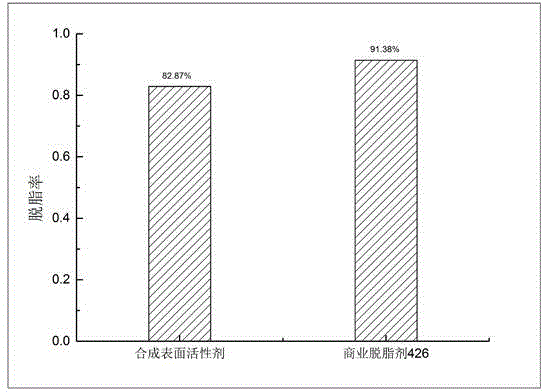Method for preparing collagen polypeptide based surfactant
A technology based on surfactants and collagen polypeptides, which is applied in the field of preparation of protein-based surfactants, can solve the problems of decreased product solubility, low yield of active ingredients, and decreased emulsifying performance, so as to reduce the total cost and reduce waste disposal. Pressure, good emulsifying effect
- Summary
- Abstract
- Description
- Claims
- Application Information
AI Technical Summary
Problems solved by technology
Method used
Image
Examples
example 1
[0017] (1) Mix 50g of waste leather shavings with 500ml of water, add 4g of sodium hydroxide and 0.5g of 2-phosphonic acid butane-1,2,4-tricarboxylic acid sodium salt, in an environment of 100°C After hydrolyzing for 10 hours, the unhydrolyzed leather residue was removed by filtration, and the resulting hydrolyzed solution was concentrated under reduced pressure to make the Baume degree reach 18.
[0018] (2) Take 40ml of oleic acid and dehydrate it in an oven for half an hour, then cool it to room temperature in a desiccator. Pour the cooled dehydrated oleic acid into a three-necked beaker, then slowly add 10ml of phosphorus trichloride dropwise under the environment of 50°C, and stir well. After 1 hour of reaction, the temperature was raised to 65° C., and the aging reaction was performed for 2 hours. After the reaction is completed, pour the product into a separatory funnel, let it stand overnight to separate layers, remove the phosphorous acid in the lower layer, and remo...
example 2
[0022] (1) Mix 60g of waste leather shavings with 600ml of water, add 4.8g of sodium hydroxide and 0.6g of 2-phosphonic acid butane-1,2,4-tricarboxylic acid sodium salt, Hydrolyze in an environment of 100° C. for 10 hours, remove leather residues that have not been hydrolyzed by filtration, and concentrate the obtained hydrolyzate under reduced pressure to make the Baume degree reach 18.
[0023] (2) Take 40ml of oleic acid and dehydrate it in an oven for half an hour, then cool it to room temperature in a desiccator. Pour the cooled dehydrated oleic acid into a three-necked beaker, then slowly add 10ml of phosphorus trichloride dropwise under the environment of 50°C, and stir well. After 60 minutes of reaction, the temperature was raised to 65° C., and the aging reaction was performed for 2 hours. After the reaction is completed, pour the product into a separatory funnel, let it stand overnight to separate layers, remove the phosphorous acid in the lower layer, and remove th...
example 3
[0027] (1) Mix 80g of waste leather shavings with 800ml of water, add 6.4g of sodium hydroxide and 0.8g of 2-phosphonic acid butane-1,2,4-tricarboxylic acid sodium salt, at 100°C It was hydrolyzed in the environment for 10 hours, and the unhydrolyzed leather residue was removed by filtration, and the resulting hydrolyzed solution was concentrated under reduced pressure to reach a Baume degree of 18.
[0028] (2) Take 40ml of oleic acid and dehydrate it in an oven for half an hour, then cool it to room temperature in a desiccator. Pour the cooled dehydrated oleic acid into a three-necked beaker, then slowly add 10ml of phosphorus trichloride dropwise under the environment of 50°C and stir well. After 60 minutes of reaction, the temperature was raised to 65° C., and the aging reaction was performed for 2 hours. After the reaction is completed, pour the product into a separatory funnel, let it stand overnight to separate layers, remove the phosphorous acid in the lower layer, an...
PUM
 Login to View More
Login to View More Abstract
Description
Claims
Application Information
 Login to View More
Login to View More - R&D
- Intellectual Property
- Life Sciences
- Materials
- Tech Scout
- Unparalleled Data Quality
- Higher Quality Content
- 60% Fewer Hallucinations
Browse by: Latest US Patents, China's latest patents, Technical Efficacy Thesaurus, Application Domain, Technology Topic, Popular Technical Reports.
© 2025 PatSnap. All rights reserved.Legal|Privacy policy|Modern Slavery Act Transparency Statement|Sitemap|About US| Contact US: help@patsnap.com



